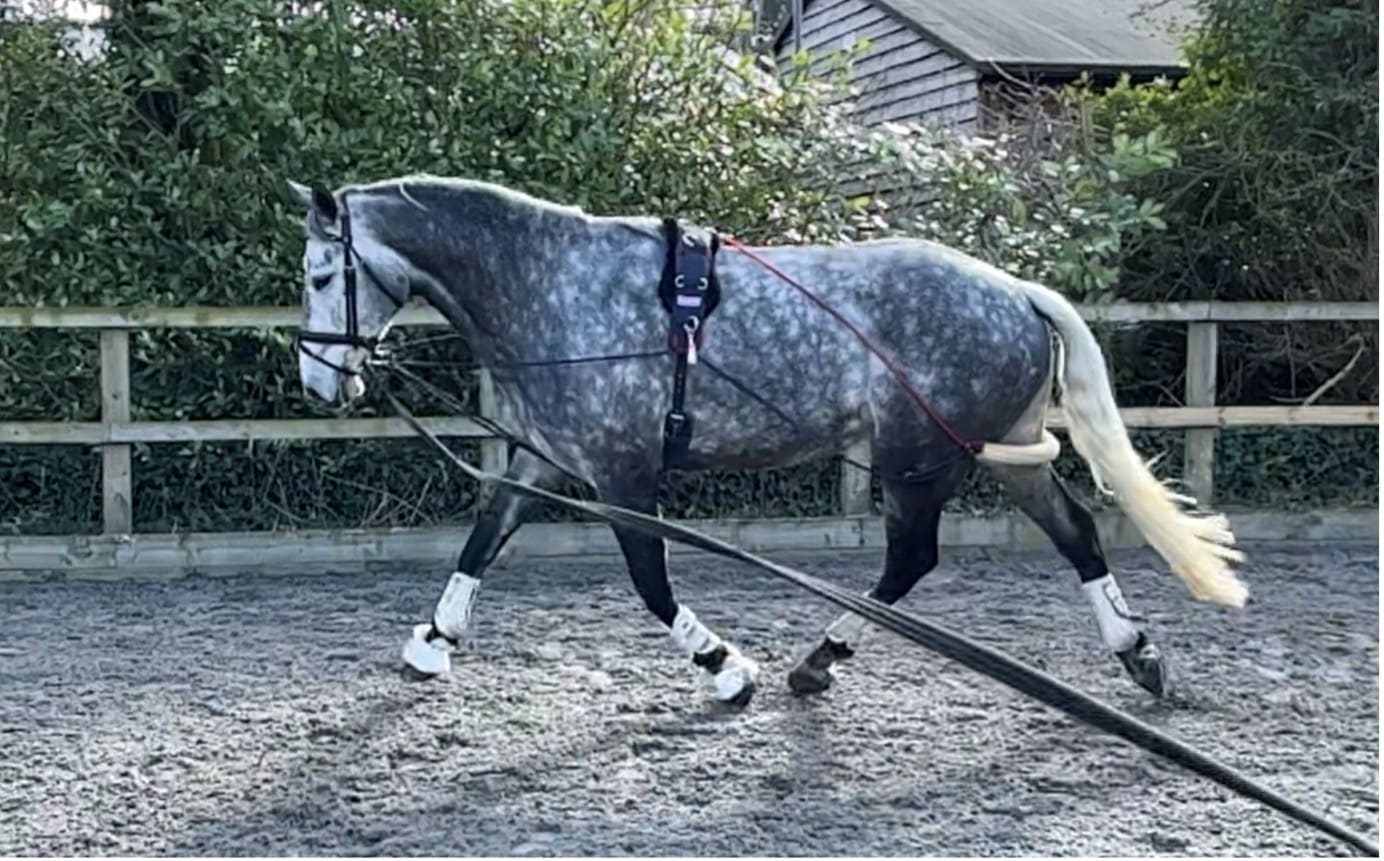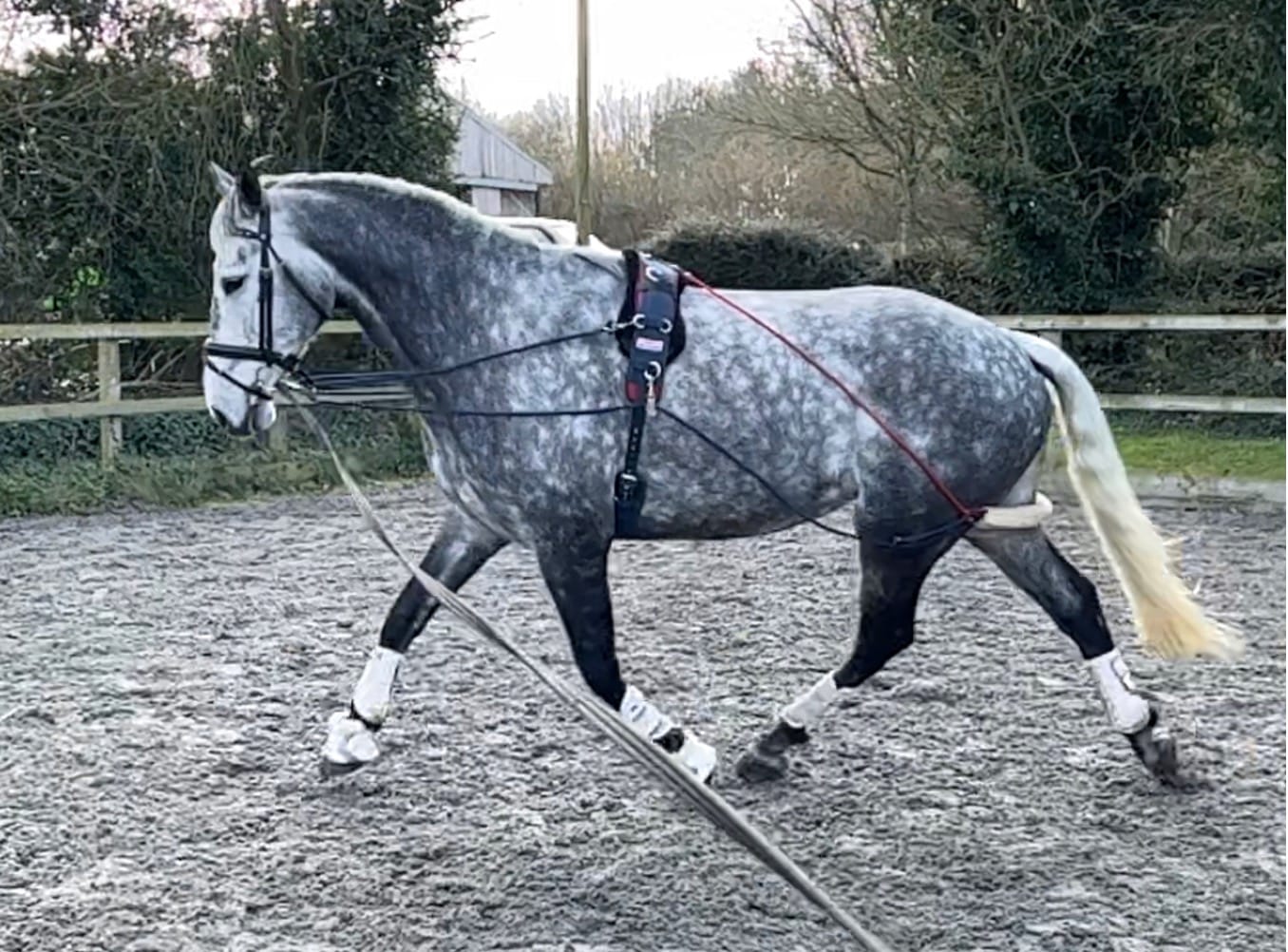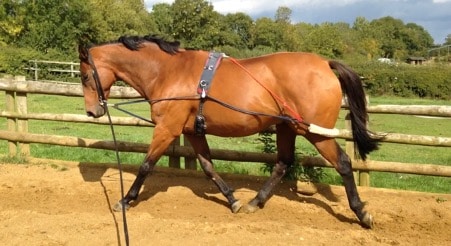Training, Training Aids, Training and Management
Training aids: the pessoa
Continuing her discussion of training aids, Chloe Mabbutt takes a closer look at the pessoa and other similar systems
Pessoas/rope-pulley systems have long been popular, with numerous variations throughout the years. The pessoa aims to encourage correct “rounding” while collecting the hindlimbs¹ with the most popular placement leading between the front legs to adjoin to a ring on the girth of the roller, designed to “stretch the topline” while engaging the hocks.
A few systems show different positions and what they aim to achieve but, have no fitting guidance, the John Whitaker Training System² being one, and the Harry Horse Lunging Support System³ ⁴ another. Many vets have recommended these systems over the years to support kissing spine rehabilitation; however, upon research, several training aid systems utilise photos for fitting that show horses in discomfort, such as hollow outlines, ears pinned back and nostrils flared⁵. Therefore, are these systems causing more harm than good?
How to use


As mentioned in the first article of this series, you should have an aim for your horse and, if they are not yet ready to collect their hindlimbs, i.e. they do not yet have a relaxed extended back posture, with the ability to engage their core, this may not be the best training aid to utilise.
The most popular setting, setting 1 (shown in Figure 1), is the least detrimental in that it is aimed to encourage low head placement preventing back hollowing, compared to setting 2, (Figure 2) which shows a more advanced collecting placement. It is also suggested a lunge cavesson be utilised, if possible during use, to prevent other interference on the bit from the lunge line.
However, even on setting 1, this training aid can be misused; the horse “held” too tightly causing an aid used to encourage relaxation, correct frame, and engagement, swiftly becoming an aid causing muscular tension and incorrect striding.
Does it actually work?
Walker et al. ⁶ found dorsoventral displacement (topline and core) increased with pessoa use when set at shoulder level (1 below setting 2 image), with greater lumbosacral joint extension during hindlimb retraction, suggesting greater back movement. However, the highest point of the horse changed from the poll to the crest, suggesting a high degree of cervical ventral flexion, which is not ideal for horses with neck pain and, is not indicative of a more uphill, engaged, and collected frame⁷.
Other research noted the pessoa on setting 1 on a treadmill did not increase core muscle use⁸, which also supports previous research finding no increase in long back muscle use with a pessoa⁹, it does not assist with spinal stabilisation, and a horse should already have good back and core musculature prior to use for collection. Additionally, Mackenchnie-Guire et al.¹⁰ found high pressures below rollers with a training aid such as a pessoa, thus indicating use during kissing spine rehab may be counter-intuitive when pressures are highest at T11-T12 which are key kissing spine locations.
Therefore, research results are not as positive as anecdotal evidence, however a lot of evidence is on short term changes, with long term benefits yet to be fully established.

How do you know you are using it correctly?
Firstly, always ensure whoever recommends an aid to you has good functional anatomical knowledge, and understands what to look for with horse movement. Secondly, ensure you know the aims you are working towards and, that it is the best aid for that aim. Thirdly, watch for the subtle cues.
A horse should not end up behind the vertical with their head, their back should not hollow, they should be able to track up effectively and, they should have relaxed ears and tail, not pinned back or swishing. Also ensure you compare before and after, if the horse could not track up before the system, and still cannot with it on, that is not a detrimental change.
Additionally, during movement it should not cause the horse to trip, to keep changing speed or stride pattern, to keep trying to alter their head position, and despite aiming to collect, it should not prevent hindlimb retraction. These can all be signs the aid is too tight or, that it is not a suitable aid for your horse.
What other exercises can be used instead of using a pessoa type system?
As this aims to collect and “engage” the hindquarters, exercises based on that aim will be discussed.
Pelvic tucks are a good exercise to engage the pelvis and encourage “rounding” of the lumbosacral joint. These should be performed by a therapist initially, to ensure the horse is capable and, for you to be shown how to complete the exercise correctly. I usually also start horses with a belly lift, to ensure they can engage their core and lift through their backs, before asking them to collect and round their pelvis, otherwise you can create torsion and “stretch” through a painful/contracted area.
Additionally, “backing up” has been shown to be an effective exercise to engage the hindlimb “power” and stabiliser muscles¹¹. It is important to ensure your horse performs this in a straight line (use poles as guides) and, in diagonal pair limb placing, this takes practise slowly with only a few strides at a time. Starting in hand and building up to more strides, on different terrains, under saddle, and even up and down hills!
Carrot stretches laterally, to the chest, and between the front legs are also great for building topline muscle¹², increasing suppleness, and encouraging “rounding”. However, ensure you start easy, with nose to shoulder, before nose to flank. If the horse’s head “twists” during the movement, and their ears do not stay horizontal, you are going out of their range.
Finally, with ridden work/exercise, start off simply, such as walk-halt transitions, trot-walk, and progressing to trot-halt and even halt-canter; these can all encourage collection and engagement. With exercises such as leg yielding in and out on a circle encouraging core engagement¹³ as well as hindlimb collection on the smaller circles. Building a good foundation OFF the horse is key to a good foundation ON the horse.
“Work with a therapist and instructor to find your horse’s “starting point” and how to effectively progress – find what works for him!”
Take home message
As mentioned in the previous article, a pessoa should be an AID to training and one tool in your tool-box. If using it, check it is not having a detrimental effect on your horse’s movement so watch them without an aid also and, mix up your training with other stable exercises and ridden ones. Finally, work with your vet, therapist and trainer to find the right methods for your horse!
References
- Williams, J., 2020. Equine training aids: can they really improve performance? UK-Vet-Equine. 4(6): https://doi.org/10.12968/ukve.2020.4.6.196
- Whitaker, J., n.d. TSR – John Whitaker Training System [online]. “How to Guide – Training System” download. Accessed: https://johnwhitaker.com/tsr–john-whitaker-training-system [28/3/22]
- GRIFFIN’S EQUESTRIAN, n.d. Harry’s Horse Lunging Aid [online]. Accessed:https://griffinsequestrian.co.uk/HarrysHorseLungingAid [28/3/22]
- HYPOStore, n.d. Harry’s Horse Lunging Support System [online]. Accessed: https://hypostore.com/harry-s-horse-lunging-support-system.html [28/3/22]
- Dyson, S., Berger, J., Ellis, A., and Mullard, J., 2018. Development of an ethogram for a pain scoring system in ridden horses and its application to determine the presence of musculoskeletal pain. Journal of Veterinary Behavior. 23: https://doi.org/10.1016/j.jveb.2017.10.008
- Walker V.A., Dyson, S.J., and Murray, R.C., 2013. Effect of a Pessoa training aid on temporal, linear and angular variables of the working trot. Veterinary Journal. 198(2): https://doi.org/10.1016/j.tvjl.2013.07.005
- Rhodin, M., 2008. A biomechanical analysis of relationship between the head and neck position, vertebral column and limbs in the horse at walk and trot [thesis]. Swedish University of Agricultural Sciences. Accessed: https://pub.epsilon.slu.se/1680/1/Rhodin_2008_1.pdf
- Williams, J., Betchley, C., Meagher, J., and Tabor, G., 2018. The effect of the pessoa training aid on equine rectus abdominus workload on a treadmill. Animal Therapy Magazine: https://animaltherapymedia.co.uk/the-effect-of-the-pessoa-training-aid-on-equine-rectus-abdominus-workload-on-a-treadmill/
- Cottriall, S., Ritruechai, P., and Wakeling, J.M., 2008. The effects of training aids on the longissimus dorsi in the equine back. Comparative Exercise Physiology. 5(3-4): https://doi.org/10.1017/S1478061509342346
- Mackechnie-Guire, R., Mackechnie-Guire, E., Bush, R., Fisher, D., Fisher, M., and Weller, R., 2018. Local back pressure caused by a training roller during lunging with and without a pessoa training aid. Journal of Equine Veterinary Science. 67: https://doi.org/10.1016/j.jevs.2018.03.018
- Blyth, C., 2018. Rehabilitation exercises improve hind leg muscle activity in horses. Summit Medical and Scientific: https://summitmedsci.co.uk/2020/02/25/rehabilitation-exercises-improve-hind-leg-muscle-activity-in-horses/ [28/3/22]
- Tabor, G., 2015. The effect of dynamic mobilisation exercises on the equine multifidus muscle and thoracic profile [thesis]. University of Plymouth. Accessed: http://hdl.handle.net/10026.1/3320
- Clayton, H.M., 2016. Core training and rehabilitation in Horses. Veterinary Clinics of North America: Equine Practice.32(1): https://doi.org/10.1016/j.cveq.2015.12.009
